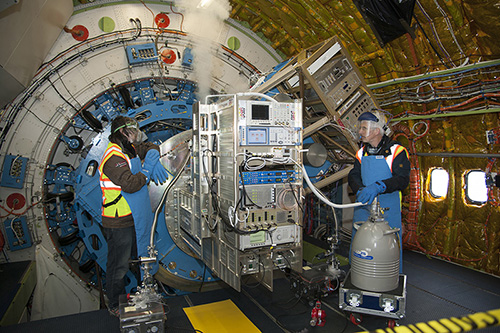
German REceiver for Astronomy at Terahertz Frequencies (GREAT)
Principal Investigator class Science Instrument
Principal Investigators:
Jürgen Stutzki
, University of Cologne, Cologne, Germany. Rolf Güsten, Max Planck Institute für Radioastronomie, Bonn, Germany.
The German REceiver for Astronomy at Terahertz Frequencies (GREAT) was a modular heterodyne instrument with multiple configurations that provided high-resolution spectra (up to R = 108) in several frequency windows between 0.4900–4.7448 THz. The front-end unit consisted of two independent dewars that operated simultaneously, each containing one of the following channels:
The upGREAT Low Frequency Array (LFA) was a 14-pixel array with two polarizations (Horizontal and Vertical with 7 pixels each) with 6 pixels arranged in a hexagonal pattern around the central pixel. Both polarizations of the array (LFAH and LFAV) could be tuned to one simultaneous or two independent frequencies in the 1.835-2.007 THz range. Tuning the LFA polarizations to two independent frequencies was offered on a best effort basis. The [OI] 145 µm line can could only be observed in V polarization, which had an additional tuning range from 2.060 to 2.065 THz.
The upGREAT High Frequency Array (HFA) was a 7-pixel array arranged with 6 pixels in a hexagonal geometry around a central pixel. The local oscillator was a Quantum Cascade Laser with a narrow tuning range limited to the [OI] 63 µm frequency of 4.74477749 THz (with a tuning range of roughly + 250 km/s to -100 km/s in LSR velocity).
4GREAT consisted of four co-aligned (to within a few arcsec) pixels at four different frequencies. The tuning ranges of these pixels were: 491-635 GHz (4G1), 890-1092 GHz (4G2), 1240-1525 GHz (4G3), and 2490-2590 GHz (4G4).
The GREAT instrument used eXtended bandwidth Fast Fourier Transform Spectrometers (XFFTS) as backends. Each XFFTS had a bandwidth of 4 GHz and 16,384 channels, thus providing a resolution of 244 kHz (note that the useful bandwidth depended on the tuning and the atmospheric transmission). The beam size of GREAT was diffraction limited (14.1” at 1.9 THz).
Primary References
"The upGREAT Dual Frequency Heterodyne Arrays for SOFIA"
Risacher, et al., 2018, JAI, 7, 1840014.
DOI:
10.1142/S2251171718400147
; ADS Bibliographic Code:
2018JAI.....740014R
"
GREAT: The SOFIA High-frequency Heterodyne Instrument"
Heyminck, S., et al., 2012, A&A, 542, L1.
DOI:
10.1051/0004-6361/201218811
Güsten, et al., "GREAT: the first-generation German heterodyne receiver for SOFIA," Airborne Telescope Systems, Ramsey K. Melugin & Hans-Peter Roeser, Editors, Proc. SPIE 4014, 23 (2000), DOI: 10.1117/12.389122 [ pdf ]
Handbook for Archive Users
Tutorials
How to View GREAT Spectra Using CLASS Utility
Finding a sample data set through modifying the baseline fit, averaging, and saving the result in a Flexible Image Transport System (FITS) file using the Continuum and Line Analysis Single-dish Software (CLASS) utility, the standard for single-dish heterodyne spectroscopy data reduction.
Data Inspection with Python
Inspection of the data structure and header information. Plotting spectra, visualizing image slices, producing moment maps, and extracting spectra.
Re-project data to GREAT resolution
Re-project other astronomical data to the pixel map of GREAT data for better comparison of the data.
Data Visualization (python/JDAVIZ)
Visualizing datacubes in 2D and 3D using the python/jdaviz tool Cubeviz and glue.
Data Visualization (CARTA)
Visualizing datacubes along the X, Y, and Z dimensions using CARTA.